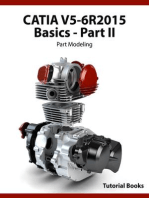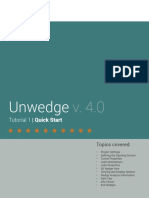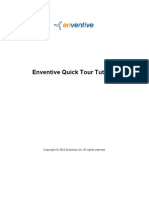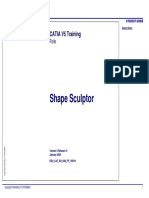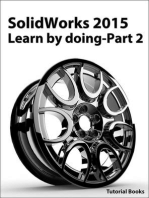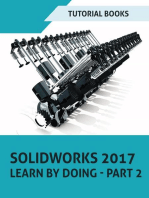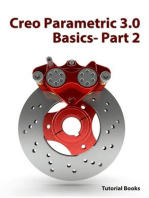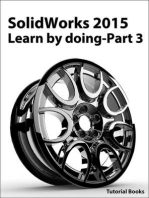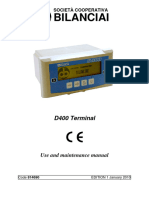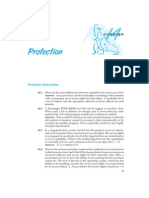Tutorial 01 Quick Start
Uploaded by
Yajaira AltuveTutorial 01 Quick Start
Uploaded by
Yajaira AltuveQuick Start Tutorial
1-1
Quick Start Tutorial
This quick start tutorial will demonstrate some of the basic features of Slide using the simple model shown above. You will see how quickly and easily a model can be created and analyzed with Slide. MODEL FEATURES: homogeneous, single material slope no water pressure (dry) circular slip surface search (Grid Search)
The finished product of this tutorial can be found in the Tutorial 01 Quick Start.slim data file. All tutorial files installed with Slide 6.0 can be accessed by selecting File > Recent Folders > Tutorials Folder from the Slide main menu.
Model
If you have not already done so, run the Slide Model program by doubleclicking on the Slide icon in your installation folder. Or from the Start menu, select Programs Rocscience Slide 6.0 Slide. If the Slide application window is not already maximized, maximize it now, so that the full screen is available for viewing the model. Note that when the Slide Model program is started, a new blank document is already opened, allowing you to begin creating a model immediately.
Slide v.6.0
Tutorial Manual
Quick Start Tutorial
1-2
Project Settings
The Project Settings dialog is used to configure the main analysis parameters for your Slide model, such as Failure Direction, Units of Measurement, Analysis Methods and Groundwater Method. Although we do not need to customize the Project Settings for this tutorial, lets take a look at the dialog.
Select: Analysis Project Settings
Figure 1-1: Project Settings dialog.
The Project Settings dialog is organized into various pages which are accessed by selecting the name of the page from the list at the left of the dialog (e.g. General, Methods, Groundwater etc.) On the General page, make sure that the Stress Units option is set to Metric. This determines the units of length, force, stress and unit weight used in the analysis. On the Project Summary page, enter Quick Start Tutorial as the Project Title. Do not change any other settings in the dialog. Select OK.
Slide v.6.0
Tutorial Manual
Quick Start Tutorial
1-3
Entering Boundaries
The first boundary that must be defined for every Slide model is the External Boundary.
An EXTERNAL BOUNDARY must be defined for every SLIDE model.
The External Boundary in Slide is a closed polyline encompassing the soil region you wish to analyze. In general: The upper segments of the External Boundary represent the slope surface you are analyzing. The left, right and lower extents of the External Boundary are arbitrary, and can be extended as far out as the user deems necessary for a complete analysis of the problem.
To add the External Boundary, select Add External Boundary from the toolbar or the Boundaries menu.
Select: Boundaries Add External Boundary
Enter the following coordinates in the prompt line at the bottom right of the screen. As you enter the coordinates, notice that the view limits are automatically updated to encompass the coordinates you are entering.
Enter Enter Enter Enter Enter Enter Enter vertex vertex vertex vertex vertex vertex vertex [esc=cancel]: 0 0 [u=undo,esc=cancel]: 130 0 [u=undo,esc=cancel]: 130 50 [c=close,u=undo,esc=cancel]: [c=close,u=undo,esc=cancel]: [c=close,u=undo,esc=cancel]: [c=close,u=undo,esc=cancel]:
80 50 50 30 0 30 c
Entering c after the last vertex has been entered, automatically connects the first and last vertices (closes the boundary), and exits the Add External Boundary option. TIP: if you make a mistake while entering coordinates, you can enter u in the prompt line at any time, to undo the most recent vertex entry. Select Zoom All (or press the F2 function key) to zoom the model to the center of the view. Your screen should now look as follows:
Slide v.6.0
Tutorial Manual
Quick Start Tutorial
1-4
Figure 1-2: External Boundary is created.
Modeling Tips and Shortcuts
While entering boundaries, various options are available by entering single letter text commands in the prompt line (e.g. enter u to undo the most recent vertex). These options are also available in the right-click context menu, and include: Undo Arc Circle Snap Options Coordinate Table
The Coordinate Table option allows you to enter or paste coordinates into a dialog. The coordinate table can be accessed by entering t in the prompt line, or from the right-click menu. Boundaries can be entered graphically in Slide, by simply clicking the left mouse button at the desired coordinates. The Snap options can be used for entering exact coordinates graphically. TIP: for more details see the Entering Coordinates topic in the Slide Help system (Slide Model > Boundaries > Overview of Boundaries > Entering Coordinates).
Slide v.6.0
Tutorial Manual
Quick Start Tutorial
1-5
Slip Surfaces
Slide can analyze the stability of either circular or non-circular slip surfaces. Individual surfaces can be analyzed, or a critical surface search can be performed, to attempt to find the slip surface with the lowest factor of safety. In this quick start tutorial, we will perform a critical surface search for circular slip surfaces. In Slide, there are 3 Search Methods available for circular slip surfaces: Grid Search, Slope Search or Auto Refine Search.
We will use the Grid Search, which is the default method. A Grid Search requires a grid of slip centers.
Auto Grid
Slip center grids can be user-defined (Add Grid option) or automatically created by Slide (Auto Grid option). For this tutorial we will use the Auto Grid option.
Select: Surfaces Auto Grid
You will see the Grid Spacing dialog. We will use the default number of intervals (20 x 20), so just select OK, and the grid will be created.
Figure 1-3: Grid Spacing dialog.
NOTE: by default, the actual locations of the slip centers within the grid are not displayed. You can turn them on in the Display Options dialog. Right-click the mouse and select Display Options from the popup menu. Select the Show grid points on search grid checkbox, and select Done. Your screen should look as follows.
Slide v.6.0
Tutorial Manual
Quick Start Tutorial
1-6
Figure 1-4: Slip center grid created with Auto Grid.
Note that the 20 x 20 grid interval spacing actually gives a grid of 21 x 21 = 441 slip centers. Each center in a slip center grid, represents the center of rotation of a series of slip circles. Slide automatically determines the circle radii at each grid point, based on the Slope Limits, and the Radius Increment. The Radius Increment, entered in the Surface Options dialog, determines the number of circles generated at each grid point. How Slide performs a circular surface search, using the Slope Limits and the Radius Increment, is discussed in the next section.
Slope Limits
When you created the External Boundary, you will notice the two triangular markers displayed at the left and right limits of the upper surface of the External Boundary. These are the Slope Limits. The Slope Limits are automatically calculated by Slide as soon as the External Boundary is created, or whenever editing operations (e.g. moving vertices) are performed on the External Boundary. The Slope Limits serve two purposes in a Slide circular surface analysis: 1. FILTERING All slip surfaces must intersect the External Boundary, within the Slope Limits. If the start and end points of a slip surface are NOT within the Slope Limits, then the slip surface is discarded (i.e. not analyzed). See Figure 1-5.
Slide v.6.0
Tutorial Manual
Quick Start Tutorial
1-7
Figure 1-5: Slope Limits filtering for valid surfaces.
2. CIRCLE GENERATION The sections of the External Boundary between the Slope Limits define the slope surface to be analyzed. The slope surface is used to generate the slip circles for a Grid Search, as follows: For each slip center grid point, suitable Minimum and Maximum radii are determined, based on the distances from the slip center to the slope surface, as shown in Figure 1-6. The Radius Increment is then used to determine the number of slip circles generated between the minimum and maximum radii circles at each grid point.
Figure 1-6: Method of slip circle generation for Grid Search, using Slope Limits and Radius Increment.
Slide v.6.0
Tutorial Manual
Quick Start Tutorial
1-8
NOTE: The Radius Increment is the number of intervals between the minimum and maximum circle radii at each grid point. Therefore the number of slip circles generated at each grid point is equal to the Radius Increment + 1. The total number of slip circles generated by a Grid Search, is therefore = (Radius Increment + 1) x (total # of grid slip centers). For this example, this equals 11 x 21 x 21 = 4851 slip circles.
Changing the Slope Limits The default Slope Limits calculated by Slide will, in general, give the maximum coverage for a Grid Search. If you wish to narrow the Grid Search to more specific areas of the model, the Slope Limits can be customized with the Define Limits dialog.
Select: Surfaces Slope Limits Define Limits
Figure 1-7: Define Slope Limits dialog.
The Define Slope Limits dialog allows the user to customize the left and right Slope Limits, or even to define two sets of limits (e.g. to define allowable ranges for slip surface starting and ending points). We are using the default Slope Limits for this tutorial, however, it is suggested that the user experiment with different Slope Limits, after completing this tutorial. Select Cancel in the Define Slope Limits dialog. NOTE: the Slope Limits can also be moved graphically, using the mouse, with the Move Limits option.
Slide v.6.0
Tutorial Manual
Quick Start Tutorial
1-9
Surface Options
Lets take a look at the Surface Options dialog.
Select: Surfaces Surface Options
Figure 1-8: Surface Options dialog.
Note: The default Surface Type is Circular, which is what we are using for this tutorial. The Radius Increment used for the Grid Search, is entered in this dialog. The Composite Surfaces option is discussed in the Composite Surfaces Tutorial.
We are using the default Surface Options, so select Cancel in the Surface Options dialog.
Slide v.6.0
Tutorial Manual
Quick Start Tutorial
1-10
Properties
Now lets define the material properties.
Select: Properties Define Materials
In the Define Material Properties dialog, enter the following parameters, with the first (default) material selected.
Enter: Name = soil 1 Unit Weight = 19 Strength Type = Mohr-Coul Cohesion = 5 Phi = 30 Water Surface = None
Figure 1-9: Define Material Properties dialog.
When you are finished entering properties, select OK. NOTE: since we are dealing with a single material model, and since you entered properties with the first (default) material selected, you do not have to Assign these properties to the model. Slide automatically assigns the default properties (i.e. the properties of the first material in the Define Material Properties dialog) for you. (Remember that when you created the External Boundary, the area inside the boundary was automatically filled with the colour of the first material in the Define Material Properties dialog. This represents the default property assignment.) For multiple material models, it is necessary for the user to assign properties with the Assign Properties option. We will deal with assigning properties in Tutorial 2.
Slide v.6.0
Tutorial Manual
Quick Start Tutorial
1-11
Analysis Methods
Before we run the analysis, lets examine the Analysis Methods that are available in Slide.
Select: Analysis Project Settings
Select the Methods page in the Project Settings dialog.
Figure 1-10: Analysis Methods in Project Settings.
By default, Bishop and Janbu limit equilibrium analysis methods, are the selected Analysis Methods. However, you may select any or all analysis methods, and all selected methods will be run when Compute is selected. See the Slide Help system for information about the different analysis methods, and the assumptions used in each. For this tutorial, we will only use the default analysis methods Bishop and Janbu. Select Cancel in the Project Settings dialog. We are now finished with the modeling, and can proceed to run the analysis and interpret the results.
Slide v.6.0
Tutorial Manual
Quick Start Tutorial
1-12
Compute
Before you analyze your model, save it as a file called quick.slim. (Slide model files have a .slim filename extension).
Select: File Save
Use the Save As dialog to save the file. You are now ready to run the analysis.
Select: Analysis Compute
The Slide Compute engine will proceed in running the analysis. This should only take a few seconds. When completed, you are ready to view the results in Interpret.
Slide v.6.0
Tutorial Manual
Quick Start Tutorial
1-13
Interpret
To view the results of the analysis:
Select: Analysis Interpret
This will start the Slide Interpret program. You should see the following figure:
Figure 1-11: Results of Grid Search.
By default, when a computed file is first opened in Slide Interpret, you will always see: The Global Minimum slip surface, for the BISHOP Simplified analysis method (if a Bishop analysis was run) If a Grid Search has been performed, you will see contours of safety factor in the slip center grid. The contours are based on the MINIMUM calculated safety factor at each grid slip center.
The Global Minimum slip surface, and the contoured grid are both visible in Figure 1-11.
Slide v.6.0
Tutorial Manual
Quick Start Tutorial
1-14
Global Minimum Slip Surfaces
For a given analysis method, the Global Minimum slip surface is the slip surface with the LOWEST factor of safety, of all slip surfaces analyzed. The analysis method is displayed in the toolbar at the top of the Slide Interpret screen.
The Global Minimum safety factor is displayed beside the slip center for the surface. In this case, for a Bishop analysis, the overall minimum safety factor is 1.14. To view the Global Minimum safety factor and surface for other analysis methods, simply use the mouse to select a method from the drop-list in the toolbar. For example, select the Janbu Simplified method, and observe the results. In general, the Global Minimum safety factor and slip surface, can be different for each analysis method.
TIP: while the analysis method is selected in the toolbar, you can scroll through the analysis methods by rotating the mouse wheel. This allows you to quickly compare analysis results, without having to select the analysis method each time. It is very important to note the following The term Global Minimum should be used with caution. The Global Minimum surfaces displayed after an analysis, are only as good as your search techniques, and may not necessarily be the lowest possible safety factor surfaces for a given model. Depending on your search methods and parameters, SURFACES WITH LOWER SAFETY FACTORS MAY EXIST!!! (For example, grid location, grid interval spacing, Radius Increment and Slope Limits, will all affect the results of the Grid Search.)
Also note In the current example, for the Bishop and Janbu analysis methods, the Global Minimum surface is the same for both methods. HOWEVER, IN GENERAL, THE GLOBAL MINIMUM SURFACE FOR EACH ANALYSIS METHOD, WILL NOT NECESSARILY BE THE SAME SURFACE!!!
The display of the Global Minimum surface, may be toggled on or off by selecting the Global Minimum option from the toolbar or the Data menu.
Select: Data Global Minimum
Slide v.6.0
Tutorial Manual
Quick Start Tutorial
1-15
The Global Minimum is hidden.
Select: Data Global Minimum
The Global Minimum is displayed.
Viewing Minimum Surfaces
Remember that the Grid Search is performed by generating circles of different radii at each grid point in a slip center grid. To view the minimum safety factor surface generated AT EACH GRID POINT, select the Minimum Surfaces option in the toolbar or the Data menu.
Select: Data Minimum Surfaces
Figure 1-12: Circular surface search Mimimum Surfaces shown.
As shown in the above figure, Slide will draw the minimum slip surfaces, with colours corresponding to the safety factor contours in the grid, and in the legend (visible in the upper left corner). Again, as with the Global Minimum, note that the Minimum Surfaces correspond to the currently selected analysis method (i.e. if you select different analysis methods, you may see different surfaces displayed).
Slide v.6.0
Tutorial Manual
Quick Start Tutorial
1-16
Viewing All Surfaces
To view ALL valid slip surfaces generated by the analysis, select the All Surfaces option from the toolbar or the Data menu.
Select: Data All Surfaces
Again, note that the slip surfaces are colour coded according to safety factor, and that safety factors will vary according to the analysis method chosen.
Figure 1-13: Circular surface search All Surfaces shown.
NOTE: since the slip surfaces overlap, Slide draws the slip surfaces starting with the HIGHEST safety factors, and ending with the LOWEST safety factors, so that the slip surfaces with the lowest safety factors are always visible (i.e. they are drawn last). The All Surfaces option is very useful for visualizing all of the valid surfaces generated by your analysis. It may indicate: areas in which to concentrate a search, in order to find a lower Global Minimum, using some of the various techniques provided in Slide. For example, customizing the Slope Limits, as discussed earlier in this tutorial, or using the Focus Search options in the Surfaces menu. areas which have been insufficiently covered by the search, again, necessitating a change in the search parameters (e.g. location of the slip center grid, or a larger value of Radius Increment).
Slide v.6.0
Tutorial Manual
Quick Start Tutorial
1-17
Filter Surfaces
When displaying either the Minimum Surfaces, or All Surfaces, as described above, you can filter the surfaces you would like displayed, using the Filter Surfaces option in the toolbar or the Data menu.
Select: Data Filter Surfaces
Figure 1-14: Filter Surfaces option.
Filtering can be done by safety factor, or by a specified number of lowest surfaces (e.g. the 10 lowest safety factor surfaces). To see the results of applying the filter parameters, without closing the dialog, use the Apply button. For example, select the Surfaces with a factor of safety below option. Leave the default safety factor value of 2. Only surfaces with a factor of safety less than 2 are now displayed. Select Done.
Figure 1-15: All slip surfaces with safety factor < 2.
Slide v.6.0
Tutorial Manual
Quick Start Tutorial
1-18
Data Tips
The Data Tips feature in Slide allows you to obtain model and analysis information by simply placing the mouse cursor over any model entity or location on the screen. To enable Data Tips, click on the box on the Status Bar (at the bottom of the Slide application window), which says Data Tips. By default, it should indicate Data Tips Off. When you click on this box, it will toggle through 3 different data tip modes Off, Min and Max. Click on this box until it displays Data Tips Max. Now move the mouse cursor over the model, and you will see that the material properties of the soil are displayed. Place the cursor over different entities of the model, and see what information is displayed. Virtually all model information is available using Data Tips, for example: slip surface safety factor, center and radius vertex coordinates grid coordinates contour values within slip center grids slope limit coordinates support properties etc etc
Click on the Status Bar and toggle Data Tips Off. You can experiment with the Data Tips option in later tutorials. NOTE that Data Tips can also be toggled through the View menu.
Figure 1-16: Data Tips display of material properties.
Slide v.6.0
Tutorial Manual
Quick Start Tutorial
1-19
Show Coordinates
Turn off the display of All Surfaces by re-selecting the toolbar button.
Select: Data All Surfaces
Model coordinates can be displayed using the Data Tips option described in the previous section. Model coordinates can also be displayed with the Show Coordinates option in the View menu.
Select: View Show Coordinates
In the Show Coordinates dialog, select the External Boundary checkbox and select Close. You will see the external boundary coordinates as shown below.
Figure 1-17: External boundary coordinates displayed with Show Coordinates.
TIP: if the coordinates appear too small, right-click and select Display Options, and under the General tab, clear the Scale Display Items checkbox. Go back to the Show Coordinates dialog and turn off the display of coordinates by clearing the External Boundary checkbox.
Slide v.6.0
Tutorial Manual
Quick Start Tutorial
1-20
Info Viewer
The Info Viewer option in the toolbar or the Analysis menu, displays a summary of Slide model and analysis information, in its own view.
Select: Analysis Info Viewer
Figure 1-18: SLIDE Info Viewer listing.
If you right-click in the Info Viewer, you will see various options available in the popup menu. The information displayed in the Info Viewer can be customized with the Info Viewer Options dialog. This is available by selecting Options from the right-click popup menu. The Info Viewer information can be copied to the clipboard using the Copy option in the Edit menu, or by right-clicking in the view and selecting Copy as Text. From the clipboard, the information can be pasted into word processing programs for report generation. Close the Info Viewer view, by selecting the X in the upper right corner of the view.
Slide v.6.0
Tutorial Manual
Quick Start Tutorial
1-21
Drawing Tools
In the Tools menu or the toolbar, a wide variety of drawing and annotation options are available for customizing views. We will briefly demonstrate some of these options. First, lets add an arrow to the view, pointing at the Global Minimum surface. Select the Arrow option from the Tools toolbar or the Tools menu.
Select: Tools Add Tool Arrow
Click the mouse at two points on the screen, to add an arrow pointing at the Global Minimum surface. Now add some text.
Select: Tools Add Tool Text Box
Click the mouse at a point near the tail of the arrow. You will see the Add Text dialog. The Add Text dialog allows you to type any text and add it to the screen. The convenient Auto-Text option can be used to annotate the model with pre-formatted input and output data, using dynamic or static text. For example: 1. In the Add Text dialog, change the Type of Text to Static. 2. Select the Global Minimum + box (NOT the checkbox). Then select the Method: Bishop Simplified + box. Then select the Method: Bishop Simplified checkbox. 3. The dialog should appear as follows:
Figure 1-19: Add Text dialog.
Slide v.6.0
Tutorial Manual
Quick Start Tutorial
1-22
4. Now select the Insert Auto-text button. The Global Minimum surface information for the Bishop analysis method, will be added to the editing area at the left of the Add Text dialog. 5. Now select OK. The text is added to the view, and your screen should look similar to Figure 1-20.
Figure 1-20: Auto-text and arrow added to view.
Editing Drawing Tools
We will now describe the following properties of all drawing tools added through the Tools menu options: Right-click If you right-click the mouse on a drawing tool, you will see a popup menu, which makes available various editing and visibility options. For example: right-click on the arrow. Copy, Delete and Format options are available in the popup menu. right-click on the text box. Various options are available, including Format, Edit Text, Rotate and Delete.
Single-click If you single-click the left mouse button on a drawing tool, this will select the tool, and you will see the control points highlighted on the tool. While in this mode: You can click and drag the control points, to re-size the tool.
Slide v.6.0
Tutorial Manual
Quick Start Tutorial
1-23
If you hover the mouse over any part of the drawing tool, but NOT on a control point, you will see the four-way arrow cursor, allowing you to click and drag the entire drawing tool to a new location. You can delete the tool by pressing Delete on the keyboard.
Double-click If you double-click the mouse on a drawing tool, you will see the Format Tool dialog. The Format Tool dialog allows you to customize styles, colours etc. Only the options applicable to the clicked-on tool, will be enabled in the Format Tool dialog. (Note: this is the same Format option available when you right-click on a tool). It is left as an optional exercise, for the user to experiment with the various editing options that are available for each Tools option.
Saving Drawing Tools
All drawing tools are automatically saved when you save a Slide file, in either the Interpret or Model programs. The Export > Tools option in the File menu can be used to save a tools file with a different name from the original Slide file. In this case, you will have to use the Import Tools option to display the tools on the model. This allows you, for example, to save different tools files, corresponding to various views of a model.
Slide v.6.0
Tutorial Manual
Quick Start Tutorial
1-24
Exporting Images
In Slide, various options are available for exporting image files.
Export Image
The Export Image option in the File menu or the right-click menu, allows you to save the current view directly to one of four image file formats: JPEG (*.jpg) Windows Bitmap (*.bmp) Windows Enhanced Metafile (*.emf) Windows Metafile (*.wmf)
Copy to Clipboard
The current view can also be copied to the Windows clipboard using the Copy option in the toolbar or the Edit menu. This will place a bitmap image on the clipboard which can be pasted directly into word or image processing applications. We have now covered some of the basic features in the Slide Interpret program. Additional features are covered in the next tutorial. That concludes this Quick Start Tutorial. To exit the program:
Select: File Exit
Slide v.6.0
Tutorial Manual
You might also like
- Slide2 Tutorials - Quick Start TutorialNo ratings yetSlide2 Tutorials - Quick Start Tutorial24 pages
- Ansys Tutorial For CFD - RSM 1st EditionNo ratings yetAnsys Tutorial For CFD - RSM 1st Edition15 pages
- Sections Tutorials Creating Section Views: Sample Lines - DWG Alignment - 1 Road Sample Line Section Name and MarksNo ratings yetSections Tutorials Creating Section Views: Sample Lines - DWG Alignment - 1 Road Sample Line Section Name and Marks3 pages
- Optimizing Fluid Flow in Static Mixer PDFNo ratings yetOptimizing Fluid Flow in Static Mixer PDF15 pages
- Tutorial 03 Toppling Planar and Wedge Sliding AnalysisNo ratings yetTutorial 03 Toppling Planar and Wedge Sliding Analysis22 pages
- Part C. Tutorial Part 1 - Creating, Analyzing and Designing The Basic ModelNo ratings yetPart C. Tutorial Part 1 - Creating, Analyzing and Designing The Basic Model5 pages
- Lab 1: Schematic and Layout of A NAND Gate: Part B: ProcedureNo ratings yetLab 1: Schematic and Layout of A NAND Gate: Part B: Procedure43 pages
- Cyclone Tips and Tricks Hexagon 2012 Final100% (1)Cyclone Tips and Tricks Hexagon 2012 Final13 pages
- Tutorial 04 Toppling Planar and Wedge SlidingNo ratings yetTutorial 04 Toppling Planar and Wedge Sliding27 pages
- COM 215 Computer Packages II Practical BookNo ratings yetCOM 215 Computer Packages II Practical Book18 pages
- Road Rehabilitation Design Using Autocad® Civil 3D® SubassembliesNo ratings yetRoad Rehabilitation Design Using Autocad® Civil 3D® Subassemblies17 pages
- UnWedge Tutorials _ 9 - Probabilistic SupportNo ratings yetUnWedge Tutorials _ 9 - Probabilistic Support14 pages
- NX 9 for Beginners - Part 2 (Extrude and Revolve Features, Placed Features, and Patterned Geometry)From EverandNX 9 for Beginners - Part 2 (Extrude and Revolve Features, Placed Features, and Patterned Geometry)No ratings yet
- SolidWorks 2015 Learn by doing-Part 2 (Surface Design, Mold Tools, and Weldments)From EverandSolidWorks 2015 Learn by doing-Part 2 (Surface Design, Mold Tools, and Weldments)4.5/5 (5)
- SolidWorks 2018 Learn by doing - Part 2: Surface Design, Mold Tools, WeldmentsFrom EverandSolidWorks 2018 Learn by doing - Part 2: Surface Design, Mold Tools, Weldments2/5 (1)
- NX 9 for Beginners - Part 3 (Additional Features and Multibody Parts, Modifying Parts)From EverandNX 9 for Beginners - Part 3 (Additional Features and Multibody Parts, Modifying Parts)No ratings yet
- NX 9 for Beginners - Part 1 (Getting Started with NX and Sketch Techniques)From EverandNX 9 for Beginners - Part 1 (Getting Started with NX and Sketch Techniques)3.5/5 (8)
- Solidworks 2018 Learn by Doing - Part 3: DimXpert and RenderingFrom EverandSolidworks 2018 Learn by Doing - Part 3: DimXpert and RenderingNo ratings yet
- Red Hat Enterprise Linux 5 Logical Volume Manager AdministrationNo ratings yetRed Hat Enterprise Linux 5 Logical Volume Manager Administration122 pages
- ECE 301 - Digital Electronics: Sequential Logic Circuits: FSM DesignNo ratings yetECE 301 - Digital Electronics: Sequential Logic Circuits: FSM Design27 pages
- Controlling Traffic Signals Through GPS For AmbulanceNo ratings yetControlling Traffic Signals Through GPS For Ambulance6 pages
- Edwards, Jonathan - Charity and Its Fruits (New York, 1852)100% (1)Edwards, Jonathan - Charity and Its Fruits (New York, 1852)566 pages
- Zero Trust Architecture: Securing The Digital Frontier: Presenter: Eng. Mohamed Adel Abdallah 2 October 2024No ratings yetZero Trust Architecture: Securing The Digital Frontier: Presenter: Eng. Mohamed Adel Abdallah 2 October 202457 pages
- Property Rental Price Prediction Using The Extreme Gradient BoostingNo ratings yetProperty Rental Price Prediction Using The Extreme Gradient Boosting6 pages
- Oral - Presentation - RT2018 - NCruz - RNC - Software - ArchitectureNo ratings yetOral - Presentation - RT2018 - NCruz - RNC - Software - Architecture14 pages
- St. Xavier'S College: Database Management System Lab Assignment #2No ratings yetSt. Xavier'S College: Database Management System Lab Assignment #27 pages
- Operating System Exercises - Chapter 14-SolNo ratings yetOperating System Exercises - Chapter 14-Sol2 pages
- Java Netbeans: Makalah Program Studi Teknik Informatika Fakultas Komunikasi Dan InformatikaNo ratings yetJava Netbeans: Makalah Program Studi Teknik Informatika Fakultas Komunikasi Dan Informatika13 pages
- Networked Option Pods Operating Instructions July 2023 v1.3No ratings yetNetworked Option Pods Operating Instructions July 2023 v1.317 pages
- CATIA V5-6R2015 Basics - Part II: Part ModelingFrom EverandCATIA V5-6R2015 Basics - Part II: Part Modeling
- Sections Tutorials Creating Section Views: Sample Lines - DWG Alignment - 1 Road Sample Line Section Name and MarksSections Tutorials Creating Section Views: Sample Lines - DWG Alignment - 1 Road Sample Line Section Name and Marks
- Tutorial 03 Toppling Planar and Wedge Sliding AnalysisTutorial 03 Toppling Planar and Wedge Sliding Analysis
- Part C. Tutorial Part 1 - Creating, Analyzing and Designing The Basic ModelPart C. Tutorial Part 1 - Creating, Analyzing and Designing The Basic Model
- Lab 1: Schematic and Layout of A NAND Gate: Part B: ProcedureLab 1: Schematic and Layout of A NAND Gate: Part B: Procedure
- Road Rehabilitation Design Using Autocad® Civil 3D® SubassembliesRoad Rehabilitation Design Using Autocad® Civil 3D® Subassemblies
- NX 9 for Beginners - Part 2 (Extrude and Revolve Features, Placed Features, and Patterned Geometry)From EverandNX 9 for Beginners - Part 2 (Extrude and Revolve Features, Placed Features, and Patterned Geometry)
- NX 9 for Beginners - Part 6 (Surface Design)From EverandNX 9 for Beginners - Part 6 (Surface Design)
- SolidWorks 2016 Learn by doing 2016 - Part 2From EverandSolidWorks 2016 Learn by doing 2016 - Part 2
- SolidWorks 2015 Learn by doing-Part 2 (Surface Design, Mold Tools, and Weldments)From EverandSolidWorks 2015 Learn by doing-Part 2 (Surface Design, Mold Tools, and Weldments)
- SolidWorks 2018 Learn by doing - Part 2: Surface Design, Mold Tools, WeldmentsFrom EverandSolidWorks 2018 Learn by doing - Part 2: Surface Design, Mold Tools, Weldments
- NX 9 for Beginners - Part 3 (Additional Features and Multibody Parts, Modifying Parts)From EverandNX 9 for Beginners - Part 3 (Additional Features and Multibody Parts, Modifying Parts)
- SolidWorks 2016 Learn by doing 2016 - Part 3From EverandSolidWorks 2016 Learn by doing 2016 - Part 3
- NX 9 for Beginners - Part 1 (Getting Started with NX and Sketch Techniques)From EverandNX 9 for Beginners - Part 1 (Getting Started with NX and Sketch Techniques)
- Solidworks 2018 Learn by Doing - Part 3: DimXpert and RenderingFrom EverandSolidworks 2018 Learn by Doing - Part 3: DimXpert and Rendering
- SolidWorks 2015 Learn by doing-Part 3 (DimXpert and Rendering)From EverandSolidWorks 2015 Learn by doing-Part 3 (DimXpert and Rendering)
- Red Hat Enterprise Linux 5 Logical Volume Manager AdministrationRed Hat Enterprise Linux 5 Logical Volume Manager Administration
- ECE 301 - Digital Electronics: Sequential Logic Circuits: FSM DesignECE 301 - Digital Electronics: Sequential Logic Circuits: FSM Design
- Controlling Traffic Signals Through GPS For AmbulanceControlling Traffic Signals Through GPS For Ambulance
- Edwards, Jonathan - Charity and Its Fruits (New York, 1852)Edwards, Jonathan - Charity and Its Fruits (New York, 1852)
- Zero Trust Architecture: Securing The Digital Frontier: Presenter: Eng. Mohamed Adel Abdallah 2 October 2024Zero Trust Architecture: Securing The Digital Frontier: Presenter: Eng. Mohamed Adel Abdallah 2 October 2024
- Property Rental Price Prediction Using The Extreme Gradient BoostingProperty Rental Price Prediction Using The Extreme Gradient Boosting
- Oral - Presentation - RT2018 - NCruz - RNC - Software - ArchitectureOral - Presentation - RT2018 - NCruz - RNC - Software - Architecture
- St. Xavier'S College: Database Management System Lab Assignment #2St. Xavier'S College: Database Management System Lab Assignment #2
- Java Netbeans: Makalah Program Studi Teknik Informatika Fakultas Komunikasi Dan InformatikaJava Netbeans: Makalah Program Studi Teknik Informatika Fakultas Komunikasi Dan Informatika
- Networked Option Pods Operating Instructions July 2023 v1.3Networked Option Pods Operating Instructions July 2023 v1.3



